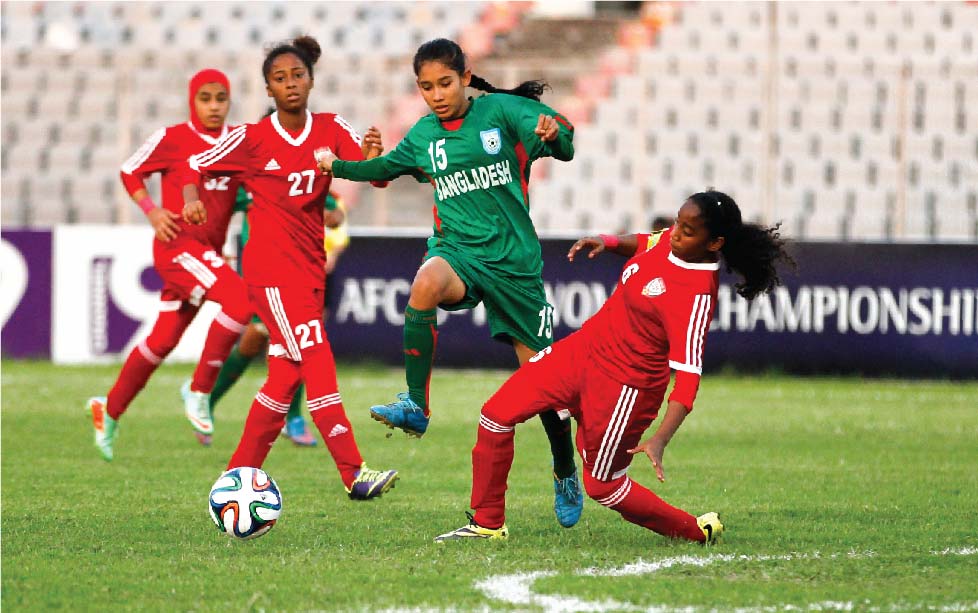By Shishir Hoque
The term ‘girl power’ might have become a cliché, but in Bangladesh football that has been the perfect adage to use, as it has not only defied long-standing taboos and paved the way for millions to cherish their dream, but also opened up many positive facades.
Even a decade ago, women playing football was almost forbidden in this pseudo-conservative society. Nevertheless, the phenomenal achievement of young women, especially youth football, has changed that perception upside down.
Bangladesh under-17 team has qualified as one of the eight best teams of Asia to play in the World Cup qualifying round, and despite their failure to cross the ultimate hurdle but to surpass the likes of India, the local powerhouse was a phenomenal achievement.
Footballing infrastructures like the introduction of women’s school football in the remotest parts of the country have played the foundational role behind the young Bangladesh girls’ eye-catching performances.

Leveling The Playing Field
Even the FIFA authorities have been discussing Bangladesh’s rise as “exemplary” and “role models” for the development of women’s football in the world.
At the start of this decade, women’s football was limited to the ethnic groups of Chittagong Hill Tracts and girls hailing from the Southwestern corner of the country. After the government-funded primary school tournaments spread all over the country, the girls from Mymensingh, Tangail, Rangpur, Thakurgaon, Kushtia, Rajshahi, Sirajganj, Gazipur, Sylhet and Cox’s Bazaar started contributing to different national youth teams, especially the one rose from the hillocks of Mymensingh.
Bangladesh Football Federation (BFF), a group of dedicated local coaches and organizers utilized government’s mega project by picking up the best talents for the national youth team.
BFF’s women’s wing committee chairman, Mahfuza Akter Kiron, recalled the situation of women’s football from the years 2008-2012 – the years when she was the deputy chairman of the same committee. “The situation of women’s football was quite the same till 2011-12. Women’s football was limited to only a few districts,” elaborated Kiron, “We received benefits from the Bangamata School Football Tournament. It created awareness of women’s football across the country and we cashed in on it. We capture the best girls and ensure them continuous training.”

The Local Scenario
Bangabandhu Gold Cup, a tournament for primary school boys was launched a year before the inauguration of Bangamata Begum Fazilatunnesa Mujib Gold Cup Primary School Football Tournament, organized by the Ministry of Primary and Mass Education, started its journey in 2011. The tournament involves more than a million young female footballers from around 64,000 schools every year. The BFF has been exclusively nurturing 39 young booters, who formed different national women’s teams in recent times, and as many as 38 of them hail from one of the largest women’s football events in the world.
So it is seen that the proper planning and execution amid limited resource may bring success and this lesson can be implemented in many aspects even beyond football in Bangladesh.
Golam Rabbani Choton, the women’s’ team coach, who is acknowledged as a wizard to guide the women’s’ national sides to claim few has been closely guiding the women’s sides since 2009, a year before the national women’s team tasted their first international football experience during the South Asian Games in 2010 came three decades after their male counterpart. He informed that a total of 36 women footballers played between 2009 and 2011, and all of them came from only five districts – Rangamati, Khagrachari, Satkhira, Jessore, and Narayanganj.
The regular squad was, however, dominated mostly by the girls coming from the ethnic minorities of Chittagong Hill Tracts, but one of the exceptions was Sabina Khatun from Satkhira. Sabina, the national and domestic top-scorer, is still captaining the national women’s team. She is also among the four-member coaching staff of the women’s youth team after completing the first part of the B-License coaching course last year.
“When I started playing, women’s football also began its journey. There was a lack of events and training facilities. Women’s football activities started to increase after 2011. The current girls have been training long-term, played a lot of matches together and bonded well, which made football easier for them,” Sabina stated in an interview.

Fostering the Future
There were some passionate coaches-turned-organizers like Akbar Ali from Satkhira, Mosleh Uddin Khandakar, popularly known as Bidyut Chacha, from Narayanganj and Emdadul Haq Shachchu from Jessore who helped the girls of their respective areas to break the social taboo and guided them all the way to Dhaka. Sabina, along with a couple of youth national players, were taught football lessons by Akbar, whose daughters Mukta and Rikta featured in the youth national team till 2012. Akbar is still active in his region. Among others, local coaches like Mymensingh’s Mofiz Uddin, Tangail’s Golam Raihan Papon, and Rangpur’s Milon Khan managed to pick up the players who are now the driving force of the national team. It is also seen that many coaches have acquired coaching licenses of Asian Football Federation by successfully passing the necessary examination.
So, it has once again shown that the passion for football and dream is there, it just needs proper juxtaposition for achieving excellence.
Another interesting feature of women’s football is the dominance of girls hailed from ethnic minorities. The ethnic minorities of the country have made a special contribution to the country’s women’s football. Being born and raised up in the hilly areas made them free, athletic and hard working. Bangladesh women’s team captain Sabina admitted that when the ethnic girls first joined the camp they were already well-built and fitter. Players like Aungmara Ching Marma and Nubai Ching Marma from Khagrachari and Trishna Chakma and Suinu Pru Marma from Rangamati were among the ones who dominated national women’s football until 2014-15.
Despite comprising only 2% of the total population, the girls from ethnic minorities have always played key roles in women’s football. Jobaida Nasreen Kona, associate professor of Anthropology department of University of Dhaka, said, “The ethnic minorities living in matriarchal societies enable the girls to be exposed to a lifestyle that makes them confident and hardworking and at the same time, helps them achieve a level of fitness, which sets them apart from the girls coming from the patriarchal societies.”
It may sound over-ambitious, but one may dream that football may play a big role to utilize the diversity of ethnicity and engulf their differences when the whole world is dangerously becoming polarized.
But the greatest impact of girls’ success so far is to ignite dreams of emancipation among thousands of girls in the country. Bangladesh is dreaming to make its name in the footballing globe, in men’s arena it may be a far cry but the ‘girl power’ is en route to achieving that.
Is that an indication of something bigger? The mean of a ‘perpetually poor’ country’s rising to the ranks? Shouldn’t we harness the great power for progress and achieve our dream?















